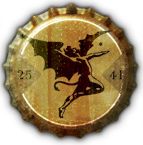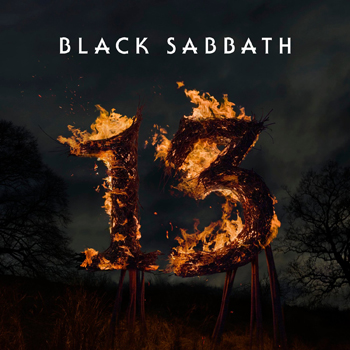Just a few hours before Black Sabbath’s Ozzfest show in Tampa (Sept. 2), guitarist Tony Iommi’s thoughts were on the weather – and it wasn’t just because hurricane Frances had caused their scheduled tour finale in Miami to be cancelled. Weather had made the entire Ozzfest tour a different experience for him. “It’s been going very, very well, much the same as all the others, really,†he said. “The only thing slightly different is the weather. We’ve had a few iffy days. It’s amazing how the fans will all stand out there when it’s raining like nothing was happening.â€
As always, Tony Iommi on Ozzfest means that a new generation of heavy metal fans gets to hear some of the all-time great metal guitar riffs right from the source. “That’s another fantastic thing,†he said, “to see the younger kids come in. But I think on these type of gigs, it’s very difficult… Our original fans would like to come to a more sedate show, indoors. These things tend to get a bit wild out of doors. It tends to keep the older fans away. It’s a shame.â€
Black Sabbath’s reunion on Ozzfest prompts the obvious question: Will there be a new Black Sabbath album? “We would hope so,†Tony said. “I’m hoping we will do another one. One of the major problems, of course, is Ozzy’s been doing a lot of other stuff with his MTV stuff. Hopefully within the next year we’ll be able to do something. I’m wrapped up at the minute doing my solo stuff and still writing, but I’ve got some stuff in hand if we do do another Sabbath album.â€
Tony uses two guitars primarily onstage – a custom SG-style guitar tuned one step down and a 1997 Gibson Custom Shop SG tuned three steps down. The Gibson is the prototype (along with a second 1997 Custom Shop SG) for Tony’s Custom Shop signature model. “I’ve been playing the Custom one,†he said. “I’ve gotten used to it now. Love it. Love it. It’s fantastic.â€
Epiphone has also just introduced an Iommi signature model. Tony has barely had a chance to try it out, but he likes what he hears. “I only got it while I was out on this tour,†he explained. “On these things, you don’t really get a sound check, and it’s hard to try things out, but I did go down one early morning and told Mike (Clement) who works for me, who does my guitar work for me, I wanted to try it. And yes, it’s really good. It’s great. I really like it.â€
Both the Custom and Epi models have a 24-fret fingerboard and signature pickups – features that Tony had already incorporated into his personal SG when he and Gibson USA got together in 1998 for his first signature model. “I actually bought a guitar company in England,†he explained. “That’s when I started working on these pickups. The company’s called Jaydee, John Diggins, he used to work for me, working on my guitar, and he went into making them and I financed him. In the early days you couldn’t get people to make you things so I decided to try it myself, to try my ideas. So I tried the 24 fret thing and tried the pickup.
“Then when I came to Gibson, I came over to Nashville. They tested the ones I had and they’d wind one and I’d try it, they’d wind another and I’d try it, until we got it.†And the pole-less pickup covers? “I like the look of that.â€
Although Tony has set the standard for dark, loud, heavy music for over three decades, it wasn’t always that way. “My father used to play accordion and harmonica, not professionally, and I started on an accordion,†he revealed. “I didn’t particularly want to, but there wasn’t a lot of choice in them days. Then after accordion the first thing I wanted to play was drums, but of course I couldn’t have any drums because they wouldn’t let me play drums in the house.â€
Inspired by the guitar instrumental records of the Shadows (the British equivalent of the Ventures), he took up the guitar. “It was the right thing,†he said. “Everybody said it was loud, but it wasn’t really.â€
His first guitar was a Watkins, a popular, inexpensive British copy of a Fender Stratocaster. As he moved on to a Burns (another British brand) and then to a real Strat, his choices were limited by his left-handed playing style. “In England you never saw left-handed Gibsons, or Strats either,†he said. ‘I was just lucky enough to find the Strat. My first Gibson, I actually played it upside down, much like Hendrix really, because you couldn’t get a left-handed Gibson. So eventually a strange thing happened to me. I bumped into a guy who played right-handed, but he had a left-handed guitar and played it upside down. I said, ‘I play upside down, too. Do you want to swap?’ It was me old SG that we used on the second album, and the third and the fourth. I’ve retired it now and just sold it to the Hard Rock.â€
Tony played in several bands as a teenager, including one called Earth, which he formed with drummer Bill Ward, bassist Terry “Geezer†Butler and singer John Osbourne, better known as “Ozzy.†His promising career as a guitarist almost didn’t happen, however, because of an accident at a sheet metal factory. “I chopped the end of my fingers off,†he recalled. “It was really ironic because the day that I did it I was going to leave that job to go professionally with this band that was going to tour Germany and Europe. I’d rehearsed with them and we were all set to go to Germany, and that totally blew it.â€
A friend gave him a record by legendary gypsy jazz guitarist Django Reinhardt, who had suffered a burn to his left hand that left him with only two working fingers, and that inspired Tony to start playing again. He reunited with his old band Earth and they changed their name to Black Sabbath.
Thirty-odd years later, Tony Iommi is the Number One heavy metal guitarist of all time, according to the March 2004 issue of Guitar World magazine, beating out everyone from Hendrix to Van Halen, not to mention Zakk Wylde, Randy Rhoades and Ritchie Blackmore. “I know they made a mistake there, didn’t they?†Tony said, laughing. “I feel embarrassed. It’s very nice. It’s funny – we often talk about it after all the years. It takes a lot of years to get recognized really, and a lot of years when we were really trying, you get the opposite – ‘They’ll never do any good.’ And then 30 years later it all turns around.â€
This news story originally appeared over on the Gibson.com website here. There’s a few pics of Tony’s guitars at the Gibson.com site, check it out.


Recent Comments